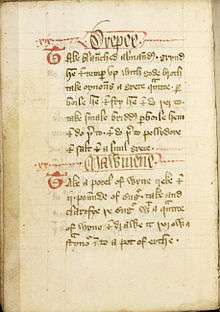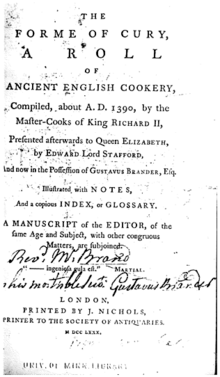The Forme of Cury
The Forme of Cury (The Method of Cooking, cury being from Middle French cuire: to cook)[2] is an extensive collection of medieval English recipes from the 14th century. Originally in the form of a scroll,[3] its authors are listed as "the chief Master Cooks of King Richard II". It is among the oldest English cookery books, and the first to mention olive oil, gourds, and spices such as mace and cloves.
 A page from late 14th-century manuscript in the John Rylands Library, Manchester.[lower-alpha 1] | |
| Author | The master cooks of King Richard II |
|---|---|
| Country | England |
| Subject | Cookery |
| Publisher | Richard II of England |
Publication date | c. 1390 |
| Pages | scroll |
Context
The scroll was written in late Middle English (c. 1390)[3][lower-alpha 2] on vellum and contains about 200 recipes (although the exact number of recipes varies slightly between different versions) with many of the same recipes as Ancient Cookery (Latin: Diuersa seruicia).[5] The Forme of Cury may have been written partly to compete with Le Viandier of Taillevent, a French cookbook created around the same time. This supports the idea that banquets were a symbol of power and prestige for medieval lords and kings.[5]
The name The Forme of Cury was given by Samuel Pegge, who published an edition of the manuscript in 1780 for the curator of the British Museum, Gustavus Brander.[3] The name has come to be used for almost all versions, although they differ from each other.[5] It is one of the best-known medieval guides to cooking.
Approach
In the preamble, the authors explain the recipes are meant to teach a cook how to make both common dishes as well as unusual or extravagant banquet dishes.[6] They also note that the recipes were written with the advice of the best experts in medicine and philosophy.[5]
Compared with another major book of medieval cuisine, Le Viandier, The Forme of Cury uses much more sugar; about 31 percent of the recipes use sugar (49 percent including fruit), compared with only 6 percent of recipes from the Viandier (8 percent including fruit).
The Forme of Cury is the first known English cookery book to mention certain ingredients such as cloves, olive oil, mace and gourds. Many recipes contain what were at the time rare and valuable spices, including nutmeg, caraway, ginger, pepper and cardamom. There are recipes for preparing many different types of animals, including whale, crane, curlew, heron, seal and porpoise.[6] There are about 10 vegetable recipes, including one for a vinaigrette salad, which indicates influence from Portugal and Spain, as French cooks rarely used vegetables at that time. There are also several pasta dishes, evidence of Italian influence.[5]
Some recipes in The Forme of Cury appear to be influenced by the Liber de Coquina, which had contributions from Arabic cuisine. For example, the recipe for mawmenee (see illustration) corresponds to the Arabic mamuniyya. The confectionery-like payn ragoun confirms the connection with Sicily (which had been Arab, Catalan and Norman), as it uses the Arab technique of cooking in soft ball syrup.[5]
Sample recipe

The following is an example of a recipe taken from the modern critical edition of the text:[7]
- Sawse madame. Take sawge, persel, ysope and saueray, quinces and peeres, garlek and grapes, and fylle the gees þerwith; and sowe the hole þat no grece come out, and roost hem wel, and kepe the grece þat fallith þerof. Take galytyne and grece and do in a possynet. Whan the gees buth rosted ynouh, take hem of & smyte hem on pecys, and take þat þat is withinne and do it in a possynet and put þerinne wyne, if it be to thyk; do þerto powdour of galyngale, powdour douce, and salt and boyle the sawse, and dresse þe gees in disshes & lay þe sowe onoward.
In modern English:
- Sauce Madame. Take sage, parsley, hyssop and savory, quinces and pears, garlic and grapes, and stuff the geese with them, and sew the hole so that no dripping comes out, and roast them well and keep the dripping that falls from them. Take the gelatin and dripping and place in a posset. When the geese is roasted enough, take and chop it in pieces, and take what is within and put it in a posset and put in wine if it is too thick. Add to it powder of galangal, powder-douce and salt, and boil the sauce and dress the geese in dishes and lay the sauce on.[8]
Modern recreations
The Café at the Rylands, in Manchester's John Rylands Library where the manuscript is kept, cooked Tart in Ymber Day, Compast, Payn Puff, Frumenty and Gingerbrede, accompanied by Piment (spiced wine), for invited guests in 2009.[9]
See also
- Apicius – a collection of Roman cookery recipes
- Utilis Coquinario – another Middle English cookbook
Notes
- The page offers recipes for Drepee ("Take blanched Almandes grynde hem and temper hem up with gode broth take Oynouns a grete quantite parboyle hem and frye hem and do þerto. take smale bryddes parboyle hem and do þerto Pellydore and salt. and a lytel grece." and Mawmenee ("Take a pottel of wyne greke. and ii. pounde of sugur take and clarifye the sugur with a qantite of wyne an drawe it thurgh a straynour in to a pot of erthe take flour of Canell. and medle with sum of the wyne an cast to gydre. take pynes with Dates and frye hem a litell in grece oþer in oyle and cast hem to gydre. take clowes an flour of canel hool and cast þerto. take powdour gyngur. canel. clower, colour it with saundres a lytel yf hit be nede cast salt þerto. and lat it seeþ; warly with a slowe fyre and not to thyk, take brawn of Capouns yteysed. oþer of Fesauntes teysed small and cast þerto.").[1])
- Ancient Origins asserts that it was written in September 1387.[4]
References
- "The Forme of Cury". Project Gutenberg. Retrieved 17 March 2016.
- "Thys fourme of cury ys compyled of þe mayster cokes of kyng Richard þe secund ... by assent of Maysters of physik and of phylosophye".--"Things sweet to taste: selections from the Forme of Cury". 1996 ISBN 0-86373-134-1
- Wright, Clarissa Dickson (2011). A History of English Food. Random House. pp. 46, 50–52. ISBN 978-1-905-21185-2.
- Sullivan, Kerry (7 October 2016). "Roasted Swan for Dinner? Oldest English Cookbook Reveals 200 Meals Fit for a King". Retrieved 21 October 2016.
- Bouchut, Marie Josèphe Moncorgé; Bailey, Ian (trans.); Hunt, Leah (trans.). "Oldcook : Forme of Cury and cookery books in English". Retrieved 24 August 2016.
- "The Forme of cury - Pygg in sawse sawge". British Library. The Master-Cooks of King Richard II. 1390. Retrieved August 23, 2016.
- Hieatt and Butler 1985, no. 32 (p. 104).
- As cooked by Clarissa Dickson Wright on the BBC Four show Clarissa and the King's Cookbook
- "Oldest English recipes cooked up at John Rylands". Manchester University. 4 December 2009. Retrieved 6 April 2015.
Bibliography
- Hieatt, Constance B.; Butler, Sharon, eds. (1985). Curye on Inglysch: English culinary manuscripts of the fourteenth century (including the Forme of cury). Early English Text Society. London: Oxford University Press. ISBN 978-0-19-722409-0. (Modern critical edition.)
- Hieatt, Constance B. (1988). "Further notes on The Forme of Cury et al.: additions and corrections". Bulletin of the John Rylands Library. 70 (1): 45–52.
External links
- British Library, Add. MS 5016, a 15th-century copy of The Forme of Cury in scroll format.
- John Rylands Library, English MS 7; (index to the images)
- The Forme of Cury at Project Gutenberg, an 18th-century edition (page images)
- Text, links and modern versions at the Foods of England project
- Pygg in sawse sawge (British Library)